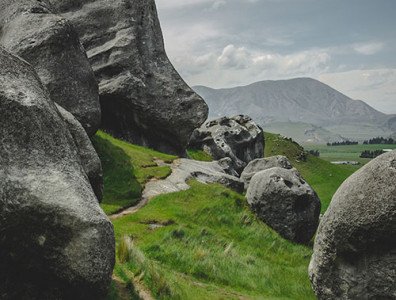How biodiversity hopes to match climate’s investing
(Bloomberg) -- More than a million species face potential demise in what might be the biggest extinction event since an asteroid wiped out the dinosaurs. Yet efforts to enlist private capital in the fight to protect the Earth’s biodiversity have barely gotten off the ground. One obvious model is the financial infrastructure that’s developed around the related goal of combating climate change, which has drawn in billions of dollars in investments. Doing the same for biodiversity faces steeper obstacles. Carbon dioxide can be measured, priced and traded. But how do you value a swamp or a newly discovered frog that pollinates flowers? Challenges in the market were highlighted in August, when a so-called debt-for-nature swap by Gabon failed to win over some investors.
1. What is biodiversity?
The variety of species within a region. Wherever robust populations of many forms of life swarm in and around each other — think tropical rainforests and coral reefs — they reinforce the ecosystem’s stability. By contrast, an area dominated by a narrower group becomes more vulnerable to sudden change if environmental conditions change. That’s one reason biodiversity and climate change are seen by scientists as intertwined crises. When tropical rain forests are burnt to expand farmland, species-rich habitats are destroyed and carbon dioxide released; in the years that follow, more frequent and intense wildfires tear through the degraded forests, destroying habitats further and releasing even more CO2.
2. How is it in danger?
As the number of humans roughly doubled between 1970 and 2022, our growing demand for food, fuel and cleared land reduced the combined populations of other vertebrate species by 69%, according to the Living Planet Index, a project of the World Wildlife Fund and the Zoological Society of London. The projection that a million species might die off, some within decades, was made by a United Nations scientific panel estimating that 10% of insect species and 25% of other plants and animals are in danger. Such a vast erosion of biodiversity poses a threat to the natural processes on which much of society is based. The World Bank has estimated that damage to the so-called natural services supported by biodiversity, like pollination of crops, water filtration and maintenance of fishing stocks, could reduce economic activity in 2030 by as much as $2.7 trillion a year, an amount close to the gross domestic product of France.
3. What’s being done?
At a 2022 UN conference in Montreal, more than 190 countries and the European Union reached a sweeping agreement including what was called the 30x30 pledge: that by 2030 they would put in place programs to protect 30% of the world’s land and oceans (up from 17% and 10% considered already protected, respectively) and repair 30% of degraded habitats. The final agreement, which, like the Paris Agreement on climate, isn’t legally binding, calls for reducing subsidies for agriculture, fishing and fossil-fuel use that encourage large-scale destruction of habitats. The US did not sign the agreement, because it never ratified the UN treaty that was the basis of the talks, but President Joe Biden issued an executive order setting a similar set of goals. Wealthier nations also agreed that by 2030 they would raise at least $30 billion a year for a new biodiversity fund, while working to boost overall investment and spending from public and private sources to at least $200 billion a year.
4. How have investors reacted?
Biodiversity has become a hot topic in global finance, with asset managers trying to replicate what has been built up in climate investing over the past 15 years. At the Montreal conference, over 150 financial institutions with more than $24 trillion in assets backed a plan to require companies to report on their “risks, dependencies and impacts on biodiversity.” Another group of investors with a combined $3 trillion in funds launched a campaign to put pressure on 100 companies with a significant impact on habitats.
5. What’s the appeal of biodiversity investing?
Climate-related investing, and the broader movement known as ESG (environmental, social and governance related investing), has become a huge and profitable business for fund managers, with total assets of more than $2.7 trillion. While there is much debate over the actual impact of ESG investing, companies that are seen as better positioned for the shift to a greener economy are attractive to many investors.
6. What’s involved?
Banks and international agencies have proposed or introduced new financing mechanisms, including:
- Green bonds, the proceeds of which are allocated to specific environmental projects, and blue bonds for marine conservation work. The World Bank and Credit Suisse even issued a “rhino bond,” raising $150 million to fund the protection of black rhinos in South Africa.
- Debt-for-nature swaps that typically help a country to cut its debts in return for allocating savings to environmental projects. Because only some of the proceeds are allocated to those projects, some deals, like a $364 million swap in Belize financed by “blue” bonds, have drawn the ire of analysts who consider the label misleading. Meanwhile some investors walked away from a $500 million swap in Gabon — the first in Africa — as it failed to generate any real debt savings for the country. Barbados and Ecuador are other countries to have secured such deals.
- Biodiversity credits, also known as biocredits or nature credits representing a unit of biodiversity improvement or protection. They’re designed to be tradable much as carbon credits are, but bought by companies to offset damage they’ve caused or as a positive contribution to nature projects. Offsets have gained a mixed reputation in climate finance as the benefits of many are overstated.
- Natural capital or biodiversity-focused funds targeting investments in companies seen as doing more than most to limit their impacts, or as providing solutions to the biodiversity crisis, like vegan “meat” makers or carbon offset developers.
7. What are the obstacles?
A big one is the lack of clear metrics of the kind that have been developed for climate-related investing. A number of nonprofits and industry task forces are working on developing them while the EU in November approved new rules for companies doing business in the bloc requiring disclosures about their impact on biodiversity loss and related ecosystem conditions.
The Reference Shelf
- The final text of the global framework agreed to at the UN’s 2022 summit on biodiversity.
- The WWF’s 2022 Living Planet Report, which includes the Living Planet Index.
- A report from the Paulson Institute on financing for biodiversity protection.
- A study by the World Economic Forum on the economic impact of the degradation of natural systems.
For more about the New Zealand governance context, please refer to the recent legal opinion on directors duties to manage nature-related risk commissioned by the Aotearoa Circle.



